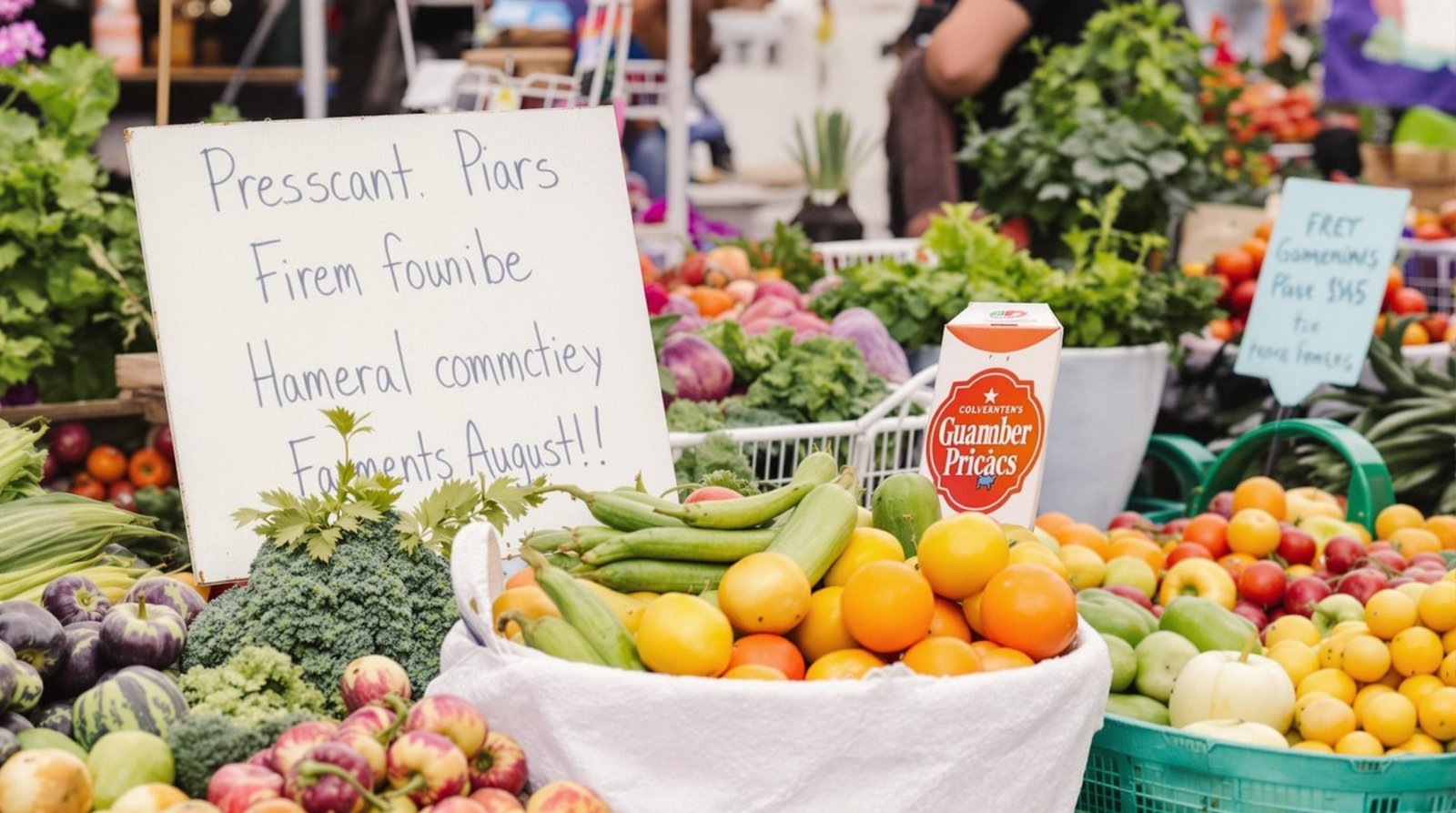Farmer’s Market Haul: What to Buy in August & How to Use It Before It Goes Bad
August’s farmers market haul offers an incredible opportunity to enjoy peak-season produce at its most flavorful and nutritious, but knowing what to buy at farmers market in august and how to preserve it before spoilage can make the difference between zero waste kitchen success and throwing money away. This seasonal produce guide will help you navigate the abundance of summer vegetables and create delicious farmers market recipes while maximizing freshness and minimizing waste.
Key Takeaways
- Prioritize highly perishable items like berries, stone fruits, and ripe tomatoes for immediate use within 3-5 days
- Store produce unwashed until ready to use, as excess moisture accelerates spoilage significantly
- Focus on August’s peak season stars: tomatoes, sweet corn, melons, peaches, and summer squash for best flavor and value
- Use preservation techniques like freezing and quick pickling to extend the life of overflow produce
- Plan your summer cooking around shelf life prioritization to minimize food waste and maximize nutrition
August’s Peak Season Bounty: What to Fill Your Basket With
August delivers some of the year’s most spectacular produce selections. The key vegetables and fruits reaching their absolute peak include tomatoes, sweet corn, peppers, eggplant, zucchini, summer squash, cucumbers, green beans, okra, broccoli, watermelon, cantaloupe, honeydew, blueberries, blackberries, raspberries, peaches, nectarines, plums, apples, and pears. In-season produce doesn’t just taste better—it boasts superior nutrient density and costs significantly less than out-of-season imported alternatives due to peak supply and reduced transport costs.
Local farmers markets showcase produce at its flavor peak, offering varieties you’ll never find in conventional grocery stores. When you’re planning what to do with zucchini or selecting the ripest stone fruits, remember that August’s abundance means you can be selective about quality while enjoying better prices.
The Must-Buy Stars of August Markets
Tomatoes reign supreme in August—this is prime tomato season when heirloom and cherry varieties are abundant and bursting with flavor. Use them fresh in salads, salsas, or roasted for rich sauces that’ll remind you why store-bought versions pale in comparison. Sweet corn demands immediate attention since its sugars convert to starch rapidly after harvest—look for fresh green husks and brown silks, then grill or boil within a day or two.
Melons like watermelon, cantaloupe, and honeydew reach peak juiciness in August. They’re perfect for eating fresh, adding to fruit salads, creating chilled soups, or blending into refreshing drinks. Stone fruits including peaches, nectarines, and plums are best eaten raw when perfectly ripe, though they also shine in pies and quick preserves. Green beans and summer squash arrive fresh and tender, making them ideal candidates for sautéing, roasting, or transforming into quick pickles.
Your Produce Timetable: What to Use First
Understanding perishability helps you plan your meals strategically. Very perishable items requiring consumption within 3-5 days include berries, cherries, peaches, nectarines, ripe tomatoes, leafy greens, okra, and green beans. These delicate items should anchor your immediate meal planning.
Medium shelf-life produce lasting up to one week includes summer squash, zucchini, cucumbers, sweet corn, and plums. However, use corn ASAP for maximum sweetness since its sugar content declines rapidly. Longer-lasting items with 2+ week shelf lives include apples, pears, uncut melons, carrots, beets, onions, and potatoes when stored properly in cool, dark locations.
Smart Storage Secrets to Make Everything Last
The cardinal rule for extending freshness: don’t wash produce until you’re ready to use it, as excess moisture accelerates spoilage dramatically. Store tomatoes at room temperature until fully ripe, then refrigerate to slow further ripening if needed.
Berries require special attention—refrigerate them unwashed in ventilated containers lined with paper towels to absorb excess moisture. Keep peaches, nectarines, and plums in the refrigerator away from ethylene producers like bananas. Corn stays sweetest when refrigerated in husks, though you’ll want to use it within a couple days as sweetness declines rapidly. Wrap leafy greens in paper towels inside plastic bags in your produce drawer to maintain optimal humidity levels.
Quick Preservation Tricks for Overflow Produce
When your farmers market haul exceeds immediate consumption capacity, smart preservation techniques prevent waste while extending enjoyment. Freeze diced peaches, nectarines, and berries by laying them on baking trays before transferring to storage bags—perfect for future smoothies and desserts.
Transform excess stone fruits, apples, or berries into jams and preserves. Apples naturally contain pectin, making them excellent thickening agents for other fruit preserves. Quick refrigerator pickles work wonderfully for green beans, cucumbers, or summer squash, creating crisp additions to Long Island farmers market bounty that’ll last weeks. Always use clean jars and store finished preserves in cool, dark areas for maximum shelf stability.
Creative Cooking Ideas for Your August Haul
Summer cooking shines when you let seasonal ingredients guide your menu planning. Grilling or roasting transforms zucchini, eggplant, peppers, and corn into versatile components for salads, tacos, and side dishes—simply drizzle with olive oil and season before cooking. For impressive grilling recipes, consider how these vegetables can elevate your outdoor cooking game.
Use tomatoes, squash, peppers, and onions in refreshing gazpacho, roasted tomato soup, or stir them into pasta sauces for concentrated summer flavors. Don’t overlook baked goods as vehicles for excess produce—incorporate zucchini, apples, or berries into breads, muffins, and cakes. Try incorporating seasonal ingredients into quick Mediterranean dishes or refreshing summer beverages that showcase your market finds.
Why Eating Seasonally Matters More Than You Think
Consuming produce soon after harvest delivers significantly higher vitamin and mineral content compared to items shipped long distances. This nutritional advantage makes your farmers market investment worthwhile beyond just taste considerations. Americans discard up to 40% of their food annually, making preservation methods and creative recipe planning crucial for reducing this staggering waste.
How to use summer vegetables effectively extends beyond immediate consumption—it’s about creating a sustainable kitchen system that honors both your budget and the environment. Eating seasonally connects you to local agricultural cycles while supporting regional farmers and reducing transportation-related environmental impacts.
Sources
Thrive Market – What Produce is in Season
Aaptiv – Store Produce in Summer
Ask the Food Geek – In Season August
Sen5es – August Preservation Tips
USDA – Farmers Markets Produce
neconserve.org – Summer Seasonal Produce Guide
Mend.me – Seasonal Produce in August
2harvest.org – Midwest Seasonal Produce Guide
latest video
news via inbox
Nulla turp dis cursus. Integer liberos euismod pretium faucibua





